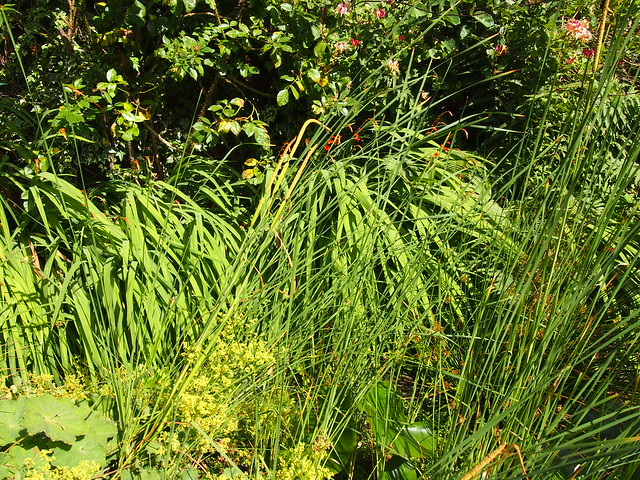One of my washing lines crosses the pond in the back garden just enough that when I spotted dusty yellow splodges on my towels I knew that the reedmace was ripe for collecting.
The flowering head, that eventually forms the familiar cigar shaped and coloured 'bullrush' is an all in one. The top part is full of pollen just now, but that will wither and crumble while the bottom solid green budding part will ripen and darken with the brown windborne seed down.
If you gently nudge the pollen heavy tip into a bag, and rattle it around a bit in there, then it'll pop back out, undamaged, ready to produce another load, while leaving it's present pollen to fall down to the bottom of the bag.
It's simple to collect, it's dry and it's only ripe for a couple of days and it's not full of insects. Indeed I found none.
I add flour to the bag and shake it all together and just use it for baking
Think plant egg
Some photos….not terribly clear, but look at the reeds and it becomes a little more obvious.
Reed mace (this is the lesser one) Middle of the photo, and top and bottom right.

Two stems coming up from the bottom left.

Sorry, rather blurry, but it does give an idea of just how much pollen the stems bear.

Showing the green 'bud' of the cigar shaped bullrush below the pollen bearing tip.

The bag of pollen I collected from nine stems.

Pollen enriched flour

Only available for a few days every year, it's rich in protein, doesn't have much taste and what it does have is quite pleasant. I just add it to the seasonal round
M
The flowering head, that eventually forms the familiar cigar shaped and coloured 'bullrush' is an all in one. The top part is full of pollen just now, but that will wither and crumble while the bottom solid green budding part will ripen and darken with the brown windborne seed down.
If you gently nudge the pollen heavy tip into a bag, and rattle it around a bit in there, then it'll pop back out, undamaged, ready to produce another load, while leaving it's present pollen to fall down to the bottom of the bag.
It's simple to collect, it's dry and it's only ripe for a couple of days and it's not full of insects. Indeed I found none.
I add flour to the bag and shake it all together and just use it for baking
Think plant egg
Some photos….not terribly clear, but look at the reeds and it becomes a little more obvious.
Reed mace (this is the lesser one) Middle of the photo, and top and bottom right.

Two stems coming up from the bottom left.

Sorry, rather blurry, but it does give an idea of just how much pollen the stems bear.

Showing the green 'bud' of the cigar shaped bullrush below the pollen bearing tip.

The bag of pollen I collected from nine stems.

Pollen enriched flour

Only available for a few days every year, it's rich in protein, doesn't have much taste and what it does have is quite pleasant. I just add it to the seasonal round
M

